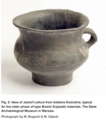Jastorf culture
This article needs additional citations for verification. (March 2019) |
| Geographical range | Roman Iron Age |
|---|
The Jastorf culture was an
Periodization (Central European culture counterpart)
- 6th century BC, Jastorf A (Hallstatt D)
- 5th century BC, Jastorf B (La Tène A)
- 400–350 BC, Jastorf C (La Tène B)
- 350–120 BC, Ripdorf (La Tène C)
- 120–1 BC, Seedorf (La Tène D)
Culture
The Jastorf culture is named after a site near the village of
The Jastorf culture extended south to the northern fringes of the Hallstatt culture, while towards the north a general congruence with the late phases of the Northern Bronze Age can be noted. Gravefields in today's Schleswig-Holstein, Mecklenburg, western Pomerania, in Brandenburg and in Lower Saxony show continuity of occupation from the Bronze Age far into the Jastorf period and beyond. The specific contributions from the various quarters witnessing the meeting of Celtic and indigenous cultures during the early periods can not be assessed by the present state of knowledge, although a shift to a northern focus has been noted to accompany the dwindling vitality of continental Celtic cultures later on.[2]
The Jastorf culture's area was first restricted to what is today northern Lower Saxony and Schleswig-Holstein. It then developed a "very expansive" character (Wolfram 1999), expanding towards the
Finds are mostly from
The southernmost extent of Germanic cultures beyond Jastorf has recently been accounted for at the final stages of the Pre-Roman Iron Age, with the paucity of Late-La Téne bracelet-types in Thuringia and northeastern Hesse proposed to suggest population movements between the central-Elbe/Saale region, Main-Franconia and the edge of the Alps and to have been triggered by the spread of the Przeworsk culture.[4] The demographic vacuum left in the south of Germany around the upper Danube and Rhine rivers, by the migrations of Celtic groups hitherto there into much richer lands in Gaul, Spain, Pannonia and Northern Italy from 400 BC probably also played a role.
Legacy
The cultures of the Pre-Roman Iron Age are hypothesized to be the origin of the
Gallery
-
Gold ornaments
-
Various artefacts
-
Reconstructed Iron Age house at Funkenburg, Germany, c. 200 BC
-
Holstein beltplate, 250-100 BC
-
Grave goods
-
Ceramic cup
-
Funerary ceramic vessels and metal brooch
-
Model of Hodde Iron Age village, Denmark, c. 100 BC[5]
See also
References
- ^ J. P. Mallory, Douglas Q. Adams (1997), Encyclopedia of Indo-European Culture, p.321
- ISBN 0-300-02863-6
- ISBN 1-56619-326-5
- ^ Mathias Seidel, Keltische Glasarmringe zwischen Thüringen und dem Niederrhein, vol. 83, no. 1, 1–43. Germania, 2005. ISSN 0016-8874
- ^ "Hodde Iron Age village". danmarksoldtid.lex.dk. 12 July 2012. Archived from the original on 1 August 2023. Retrieved 7 August 2023.
Sources
- J. Brandt, Jastorf und Latène. Internat. Arch. 66 (2001)
- W. Künnemann, Jastorf – Geschichte und Inhalt eines archäologischen Kulturbegriffs, Die Kunde N. F. 46 (1995), 61–122.
- Herwig Wolfram, Die Germanen, Beck (1999).
- Heinrich Krüger: Die Jastorfkultur in den Kreisen Lüchow-Dannenberg, Lüneburg, Uelzen und Soltau. 1961, ISBN 3-529-01501-6
- Martens, Jes (2014), "Jastorf and Jutland (On the northern extent of the so-called Jastorf Culture)", Das Jastorf-Konzept und die vorrömische Eisenzeit im nördlichen Mitteleuropa
- Wofagiewicz, Ryszard (1997), "The Pre-Roman Iron Age in Pomerania", Chronological Problems of the Pre-Roman Iron Age in Northern Europe, Arkæologiske skrifter, vol. 7








![Model of Hodde Iron Age village, Denmark, c. 100 BC[5]](http://upload.wikimedia.org/wikipedia/commons/thumb/0/05/Hodde_Iron_Age_village%2C_Denmark%2C_c._100_BC.png/120px-Hodde_Iron_Age_village%2C_Denmark%2C_c._100_BC.png)